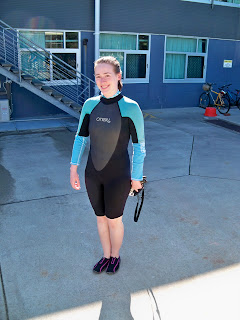Science never goes as planned. I think my group has completely re-worked our experimental design at least 4 or 5 times today. We started the morning out with gathering supplies, setting up equipment, and discussing our plan of attack - all fairly straight forward. Since we need to wait until Friday to have "old" dead fish available to us (we are testing freshly dead vs. 3-day old fish in this experiment, and their respective rates of uptake in a sandy shore environment), we decided to perform a trial run of attaching fish to the sand flat to perfect our methods. The initial idea was that we would observe fish stuck to the benthos (bottom environment) twice daily, with the expectation that we could observe the same fish getting slowly consumed over the course of several days.
So we took four freshly dead fish, and attached each of them to the sand with a different method - staking, tying to a rock, etc. The first fish was easy to place, as it was tied to a rock, and we moved on a few paces. We stuck the second fish through with two tent stakes (head and tail)...it looked a bit like a morbid, sacrificial offering. We walked another few paces to place a fish that was attached to a stake using wire. One of our group members looked back towards the previous site. "Didn't that fish have a tail?" he asked. "I don't think all of them did," was the response, presuming that he was talking about the tail fin - some of which had been missing from the fish to begin with.
Well, no, actually by "tail" he meant "entire body." We'd been gone from the double-staked fish for about two minutes, and it was now mostly just a floating head, with no sign as to what had eaten it. So much for our ability to "observe the fish over the course of three days"!! We placed our fourth fish (tied to two tent stakes with fishing line), and then decided to stand and observe for 10 minutes. The fish that had been damaged by stakes or wire were partially consumed by small fish within that time period, though the other (un-mutilated) fish were untouched. [We have since decided to consider this damaged vs. non-mutilated variable in our experiment, but that's a different story.] We decided to come back and check the fish in 2 hours.
Two hours later, we waded back out to our sample site. Not only were all four fish completely gone, but one of our stakes from the tied-to-two-stakes fish had been ripped out of the sand and dragged along the bottom for several meters. Obviously something pretty big had come along and found a great snack! But back to the drawing board for us.
At the research station
A nice bag of dead fish, waiting on a table (in a caged area) for the next three days
Arts and Crafts for Biologists: designing buoys, markers, and methods of fish attachment
Looking out towards our study site in the bay; very pretty, but not without challenges
Suiting up for field work!





No comments:
Post a Comment